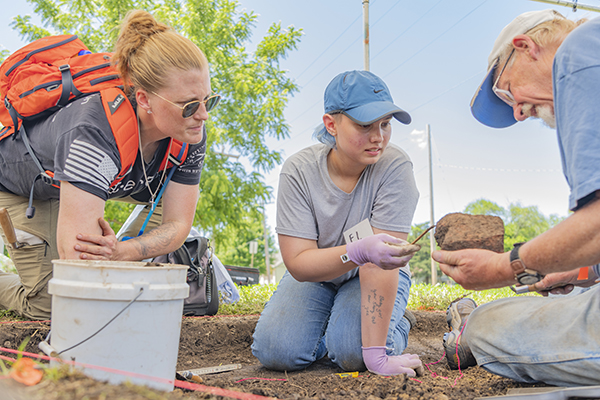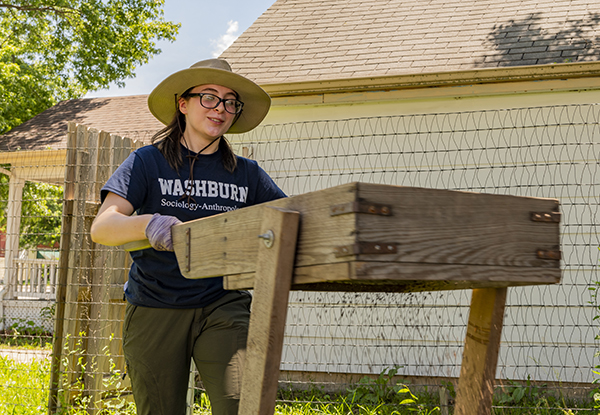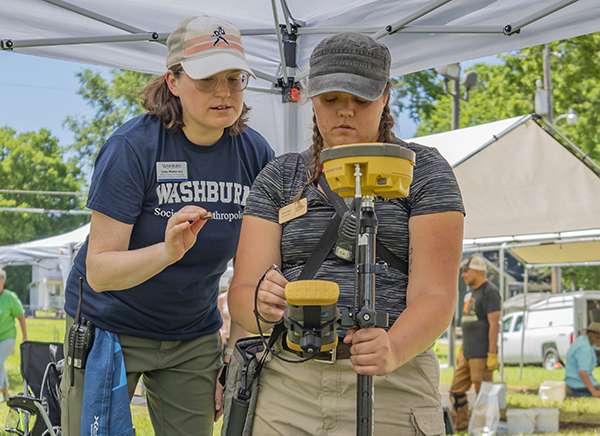Under the Surface
Archaeology students explore Brown v. Board site before historic court case

Student El Miller (center) just found this brick while digging in a plot at the Brown v. Board of Education National Historic Park. Kansas Anthropological Association ambassador Bill Olson investigates it for markings while fellow student Savannah Cusack (left) looks on. Photo by Jeremy Wangler
From The Ichabod - Fall 2022
By Jeremy Wangler
The Brown v. Board of Education National Historical Park is an icon in Topeka and a landmark on the road to racial equality in the United States. This summer, Washburn University archaeology students joined Kansas Historical Society and Kansas Anthropological Association employees and volunteers in digging deeper into the history of the land owned by the National Park Service.
With signs of their urban environment all around them – neighbors checking in, lawn mowers humming, ambulance sirens in the distance and the Topeka skyline just to the north – they explored the area around the museum, and just a foot or two below the surface, they found artifacts that will help piece together the history.
“The National Park Service wanted to do more interpretation and really understand early Topeka life in this neighborhood before this was a school,” said Shelby Beltz, ba ’18, archaeologist, KHS.
Seven students enrolled in Associate Professor Laura Murphy’s Archaeological Field School, a summer class that includes two weeks at the site and the rest of the time analyzing their finds and preparing a presentation. The National Park Service scanned the ground surrounding the Monroe Elementary School using geophysical equipment to look for signatures of buried structures. This survey guided the decisions on where to dig.
“You don’t really know a lot about what went on here other than after the Supreme Court case,” said Tori Shaw, a junior anthropology major. “We studied maps and historical records that were provided in the field manual, and it doesn't seem like the community that existed here really got their story told.”
Shaw’s dig unit was south of the Monroe Elementary School building, which is now the National Park Service museum. Her group was looking for evidence of a home belonging to a woman named Lulu Perkins in the early 1900s.

(Tori Shaw sifting through soil at the Brown v. Board dig site. Photo by Jeremy Wangler)
Curiously, the geophysical survey did not show evidence of a previous structure, but historic maps did. Shaw predicted it was a shack-like building without a foundation. One week into the dig, Shaw’s unit found a trove of artifacts including ceramic plates, window glass and an inkwell.
“It was this really exciting moment where I thought there could be evidence of somebody who resided here, whether the house was bulldozed or demolished or something. We know there are signs of residence because of all the household items.”
On the northeast side of the school, El Miller, a junior anthropology major, and their group were looking for signs of privies based on the geophysical signatures and the historic maps. The group ended up finding a sidewalk and a building foundation, and Miller found one of the first bricks.
“It’s exhilarating,” they said. “Finding something someone left from the past is really interesting.”
Miller has always been interested in history and is majoring in anthropology.
“Dr. Murphy told me about the class, and I got really excited about it,” Miller said. “I thought it would be the perfect fit, and this ended up cementing that I really want to do archaeology field work.”
Beltz is one of Murphy’s former students, and the professor is proud to see the graduate mentor her current students.
“It's really great to see students leave and graduate, follow their passions and do exactly what they studied,” Murphy said. “And having Shelby mentor my own students right now, it gives them a sense of what it takes to become a professional archaeologist.”

(Shelby Beltz, ba ’18, takes measurements while Laura Murphy, associate professor, archaeology, assists. Photo by Jeremy Wangler)
The students learn digging techniques, mapping, data recording and proper use of the equipment. They came into the summer as seven individuals and finished as a team.
“There's only so much you can teach in the classroom,” Murphy said. “They were all a little apprehensive at first. Now that we have watched some of them take on real leadership roles, it's just great.”
“We kind of broke them out of their shell,” Beltz said.
Murphy hopes she can start offering the class more often, working at different sites throughout the region. She offered it once before, but the pandemic kept her from doing it for two years.
“It would be nice to get back on a regular schedule,” she said. “I would love to have more students get field experience and do these hands-on activities and interact with the community. It's been really beneficial for them.”
Unlike most digs, these archaeologists-in-training got to sleep in their own beds at night and make an impact in their own community.
“I hope the end result of this research is we have a lot more data and artifacts that put together how people lived here,” Shaw said. “It's something that has probably been ignored; other than people knowing about the Supreme Court case, we haven’t considered there's an entire history and community.”